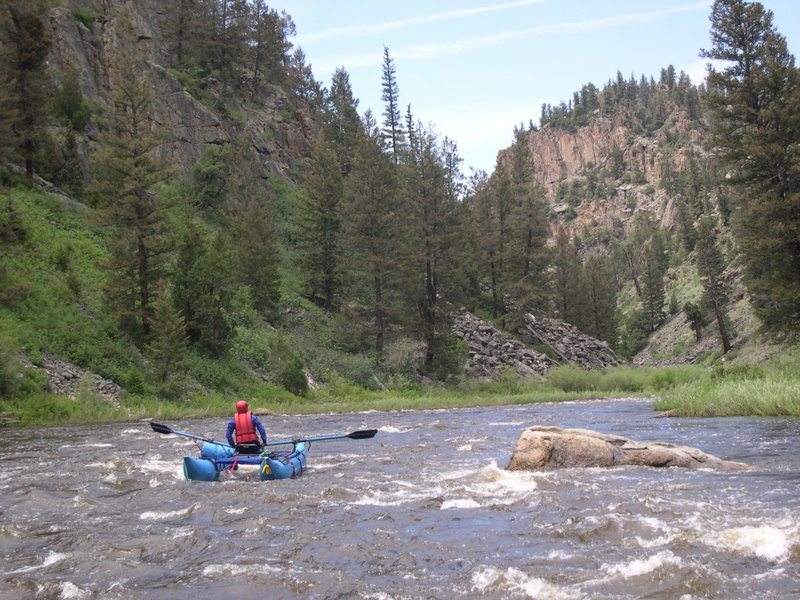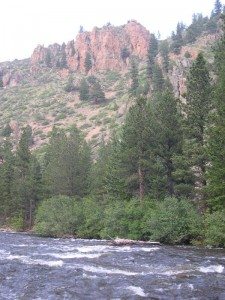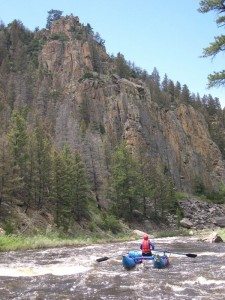High Adventure Going Light in Colorado
Having just gotten married a couple years before, we decided to spend our “second honeymoon” doing what we both love, rowing our catarafts down beautiful and exciting rivers. This summer was to be a Colorado odyssey, full of adventure and chasing my beautiful wife all over on the river (and off!). Leaving California, we headed straight for Colorado, stopping off in the Denver area to see relatives before heading for the Cache la Poudre River, near Fort Collins. With a snug lodging, hot weather, and traveling with the woman I love, it was awesome.
Cache La Poudre
The Poudre is an excellent roadside river with sections from Class II (think inner tubes) to Class V+ (the narrows, gnarly). Access is easy, a minor highway runs right along the river, providing many options to put-in or take out. We ended up doing the “profile rock and roll” section (Class III), the “rustic” runs (Class III), “Grandpa’s gorge” (Class III+), “upper Mishawaka” (Class IV) and “lower Mishawaka” (Class III). All were very fun and scenic. We did most sections several times as they are relatively short. We either hitched or rode the bike for shuttle. A friendly camper shuttled us one day just to watch us run. My favorite run was the Upper Mishawaka because you can pull in at the Mishawaka Inn for an ice cold microbrew and burger before running the lower Mishawaka.
North Platte
After some great days on the river, it was up and over the pass to the North Platte. Straddling the Colorado/Wyoming border is the Northgate Canyon run (Class III). With the exception of one rapid, this day run is mostly Class II. It is a very pretty canyon with excellent fishing. We ended up setting shuttle with another group we met at the put-in. This was only possible because we had the boats and gear ready to go and could drop and go within minutes. We did the day run of about 8 miles, but you could do 30+ miles and fish the whole way. We saw bighorn sheep on a hike down river the day before the run. The takeout at Six Mile Gap campground is about a ¼ mile hike up a steep, but good path. I ended up carrying my boat out solo (gotta Go Light!) and then helping my wife with her boat (which is even lighter…).
Eagle River
Next on the agenda was the Arkansas River, but on our way to the Arkansas, we stopped and ran the “Dowd Chute” and “upper eagle” sections of the Eagle River near Minturn. Dowd’s chute is a pretty straightforward mile long set of waves that was called Class IV. It definitely is not a place to swim. It was very shallow with sharp rock debris and very fast current. The upper Eagle is a fast, continuous Class II+ and III section that rolls past private houses, condos, and golf courses. The shuttle was interesting as we took public transit (the bus) to the put-in to get the truck.
The Ark
The Arkansas River is perhaps the most heavily used whitewater river in the country, but everyone goes on a couple of sections, leaving the rest of the river to people who don’t like crowds. In our week there, we ran the “Numbers” (Class IV) combined with “Fractions/Frog Rock” (Class III-III+) several times, and ran “Browns Canyon” (Class III) and the “Royal Gorge” (Class III). We met some great people who had a place on the river where we could camp and they came over and boated with us several times.
The combination of Numbers/Fractions/Frog Rock is a great one-day run down to the town of Buena Vista, with time to play on the surf wave in the whitewater park. There is a fair amount of use on the Numbers section, but crowds can be avoided with proper timing. We rarely saw many boaters on the Fractions/Frog Rock section. Numbers is a very fun section with lots of read and run Class IV. Fractions/Frog Rock is full of fun surf waves and the whitewater park in Buena Vista has a great wave. The play park in Salida also looked like a great spot to play.
Browns Canyon is reputed to be the busiest whitewater section in the country. It was definitely crowded while we were there. It has great scenery, but relatively easy whitewater. The Royal Gorge is a beautiful section of the Arkansas with a deep gorge, good rapids (watch out for the BIG holes), and great scenery. Alas, all this is somewhat spoiled by the presence of the train, railroad debris along the river, the helicopters buzzing up the canyon, and the multitude of commercial rafts with no clue about boat control.
Taylor River
After the Arkansas, we headed for the Gunnison, stopping to play a bit on the Taylor River near Almont. The upper Taylor was a fun little Class III with a surprising amount of commercial traffic. It is dam controlled with little access in the upper end due to private fishing lodges. The run is relatively continuous with fairly easy rapids. We used our bicycle to shuttle as it was only about 5 miles. On our way through Gunnison we checked out the whitewater park there. It looked good, but we didn’t get the boats out to play as we were headed for the gorge.
Gunny Gorge
The Gunnison Gorge (Gunny Gorge) starts just below the famed “Black Canyon” of the Gunnison where you have to be both an accomplished Class V+ boater and rock climber to make it through. The Gunny Gorge is a more mellow (Class III) run through a very pretty canyon. Access to the canyon is down the Chukar Trail, a downhill hike of about a mile. We had the local horse packer haul our gear down and carried our light frames (they don’t break down) into the canyon ourselves. It wasn’t a bad hike as the frames only weigh about 35 pounds.
Because we were traveling light, it only took one horse to pack all of our gear into the canyon. When you’re paying by the horse, an extra cooler or dry bag can become very expensive! Even the horse packer was surprised at the minimal amount of gear and the size/weight of our boats. He couldn’t believe that our two boats fit into one small boat bag. He was even more surprised when the bag containing two catarafts, the top off pump and all the straps to rig them weighed in at less than 80 pounds on his scale. All of the food for our 3 day trip (plus eating utensils) easily fit into our waterproof 2 gallon screw-top bucket. Other than a medium drybag with clothes, sleeping bags, and sleeping pads, there wasn’t anything else to pack.
The rapids were surprisingly easy, leading us to rate other later runs/rapids a bit differently. We would ask ourselves “was that a Class II or a Gunny Class III?” After the Gunny Gorge we hiked some side canyons of the Gunnison. There’s nothing better than escaping the heat (and bugs) by skinny-dipping in cool, isolated pools with no one around but your beautiful wife.
Selway River
Just when we thought our trip was winding down, a friend called with a great idea to run the Selway River in Idaho after the permit season ended. As we have another friend that lives near there, we headed that way and ended up doing 5 days on the Selway (without him) at low water. This is a premier run that at low water is mostly a very rocky, technical Class II-III run. There is at least one Class IV at this level though, so not for beginners. With the low water level, you definitely want to Go Light.
Payette River
Heading back from the Selway, we decided to travel along the Payette River to see if we could get any more river time. The NF Payette was running strong so we scrounged a promise of a ride for the Cabarton run (Class III) from another group of boaters. Not many people want to do the 17 mile Class V section, including us. As we were waiting at the put-in, who shows up our friend that suggested the Selway and his traveling companion! So we ran that day with them and then camped together along the SF Payette. The next day, we helped each other with shuttle so they could run swirly canyon (Class II+) and we could run the “staircase” section of the SF Payette (Class IV) and then the Main Payette (Class III).
Over the course of about 6 weeks, we did a lot of runs on a lot of different rivers. Part of what made the river part of the trip successful was having lightweight boats and gear that we could handle solo, being ready to go in minutes, and meeting some really neat people that let us tag along and helped with shuttles. Our boats weigh less than 100 pounds (boat, frame, oars combined) so we can carry them to or from the river easily. Plus we keep the gear load to a minimum and utilize nonperishable foods so we don’t have to take a cooler.




